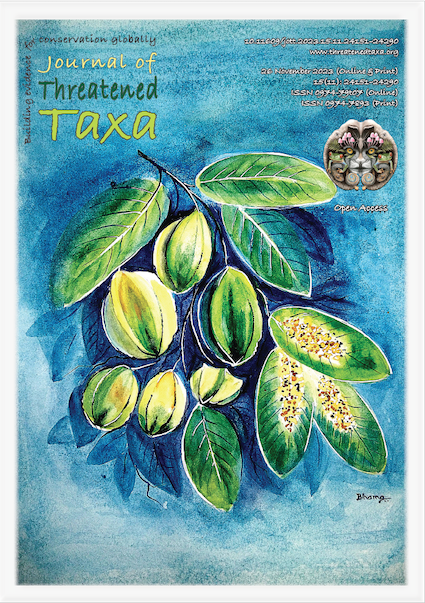A preliminary observation on the nesting of the Indochinese Roller Coracias affinis Horsfield, 1840 (Aves: Coraciiformes: Coraciidae) in Assam and northern West Bengal, India
Main Article Content
Abstract
The nesting of Indochinese Roller was observed in Rani, Kamrup, Assam for 49 days in April–May 2022. The male was noted hunting more frequently compared to the female, but its prey items consisted of smaller biomass than those the female hunted. Opportunistically, more nests were recorded at Buxa Tiger Reserve, West Bengal and Kaziranga National Park, Assam. The preferred tree species for nesting were Sal Shorea robusta, Mynah Tetrameles nudiflora, and Koroi Albizia procera; the preferred nest height was 9.2 m.
Article Details

This work is licensed under a Creative Commons Attribution 4.0 International License.
Authors own the copyright to the articles published in JoTT. This is indicated explicitly in each publication. The authors grant permission to the publisher Wildlife Information Liaison Development (WILD) Society to publish the article in the Journal of Threatened Taxa. The authors recognize WILD as the original publisher, and to sell hard copies of the Journal and article to any buyer. JoTT is registered under the Creative Commons Attribution 4.0 International License (CC BY), which allows authors to retain copyright ownership. Under this license the authors allow anyone to download, cite, use the data, modify, reprint, copy and distribute provided the authors and source of publication are credited through appropriate citations (e.g., Son et al. (2016). Bats (Mammalia: Chiroptera) of the southeastern Truong Son Mountains, Quang Ngai Province, Vietnam. Journal of Threatened Taxa 8(7): 8953–8969. https://doi.org/10.11609/jott.2785.8.7.8953-8969). Users of the data do not require specific permission from the authors or the publisher.
References
Altmann, J. (1974). Observational study of behavior: sampling methods. Behaviour 49(3/4): 227–267.
Ali, S. & S.D. Ripley (1987). Compact Handbook of the Birds of India and Pakistan together with those of Bangladesh, Nepal, Bhutan and Sri Lanka. Oxford University Press, Delhi, 847 pp.
Anonymous (2022a). Dundubia annandalei Boulard 2007 – Comb Scraper. Marathe, K., V. Sarkar, B.W. Price, P. Roy & K. Kunte. Cicadas of India, v. 1. Indian Foundation for Butterflies. http://www.indiancicadas.org/sp/577/Dundubia-annandalei. Accessed 13 May 2022.
Anonymous (2022b). Haphsa scitula Distant, 1888. Marathe, K., V. Sarkar, B.W. Price, P. Roy, & K. Kunte. Cicadas of India, v. 1. Indian Foundation for Butterflies. https://www.indiancicadas.org/sp/273/Haphsa-scitula. Accessed 13 May 2022
Barve, S., T.R.S. Raman, A. Datta & G. Jathar (2020). Guidelines for conducting research on the nesting biology of Indian birds. Indian BIRDS 16(1): 10–11.
Biddulph, C.H. (1937). The Southern Indian Roller or Blue Jay [Coracias benghalensis indica (Linn.)] killing a small snake. Journal of the Bombay Natural History Society 39: 865.
Gill F., D. Donsker & P. Rasmussen (eds). (2021). IOC World Bird List (v13.1). https://doi.org/10.14344/IOC.ML.13.1. Accessed 14 November 2023.Johansson, U.S., M. Irestedt, Y. Qu & P.G.P. Ericson (2018). Phylogenetic relationships of rollers (Coraciidae) based on complete mitochondrial genomes and fifteen nuclear genes. Molecular Phylogenetics and Evolution 126: 17–22. https://doi.org/10.1016/j.ympev.2018.03.030
Palmer, A.G., D.L. Nordmeyer & D.D. Roby (2001). Factors influencing nest attendance and time activity budgets of Peregrine Falcons in interior Alaska. Arctic 54(2): 105–114.
Schantz, T.V. & I.N. Nilsson (1981). The reversed size dimorphism in birds of prey: a new hypothesis. Oikos 36(1): 129–32. https://doi.org/10.2307/3544388
Sivakumaran, N. & K. Thiyagesan (2003). Population, diurnal activity patterns and feeding ecology of the Indian Roller Coracias benghalensis (Linnaeus, 1758). Zoos’ Print Journal 18: 1091–1095. https://doi.org/10.11609/JoTT.ZPJ.18.5.1091-5
Tucker, G.M. & M.F. Heath (1994). Birds in Europe: Their Conservation Status. Birdlife Conservation Series No. 3. BirdLife International, Cambridge, United Kingdom, 600 pp.
Vishnu, S.N. & C. Ramesh (2021). Predation on a Common Wolfsnake, Lycodon aulicus (Colubridae), by an Indian Roller, Coracias benghalensis (Coraciidae), in the Sathyamangalam Tiger Reserve, Tamil Nadu, India. Reptiles & Amphibians 28(1): 157–158. https://doi.org/10.17161/randa.v28i1.15379

